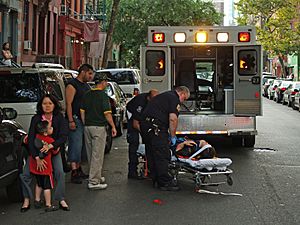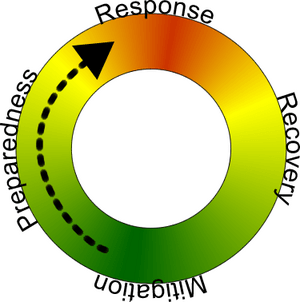Emergency facts for kids
An emergency is a serious situation that needs quick action. It's when there's a danger to people's health, their life, their belongings (called property), or the environment. Most emergencies need fast help to stop things from getting worse.
Some emergencies are very clear, like a big natural disaster such as a tornado or flood. But other times, it might be a smaller event. Someone watching needs to decide if it's truly an emergency. Governments usually have special groups, called emergency services, that plan for and handle these situations.
Contents
What Makes Something an Emergency?
For something to be called an emergency, it usually fits one or more of these descriptions:
- It puts life, health, property, or the environment in immediate danger.
- It has already caused harm to people, their health, their belongings, or the environment.
- It has a high chance of quickly becoming a danger to life, health, property, or the environment.
In the United States, some laws say that if someone needs to use a phone line to report an emergency, others must let them. This shows how important it is to report emergencies quickly.
Most emergency services agree that protecting human health, life, and property is key. However, some groups don't always see environmental dangers as equally important. This can also apply to animal welfare. Some emergency groups help animals by calling them "property" if they are owned. This means they might not help wild animals in danger. The way agencies respond often depends on what the local government thinks is most important.
Different Types of Emergencies
Emergencies Threatening Life
Many emergencies put people's lives in immediate danger. This can be a single person, like someone having a heart attack, stroke, or cardiac arrest. It can also be a large group of people affected by natural disasters. These include tornadoes, hurricanes, floods, earthquakes, and mudslides. Outbreaks of diseases like cholera or Ebola are also life-threatening emergencies.
Most emergency groups see these as the most important type of emergency. This is because nothing is usually considered more important than human life.
Emergencies Affecting Health
Some emergencies might not immediately threaten life, but they can seriously affect a person's health and well-being. A health emergency can sometimes become life-threatening later on.
The causes of health emergencies are often similar to those that threaten life. This includes medical problems and natural disasters. However, many more situations can be called health emergencies. For example, a broken arm usually won't cause death. But it needs quick help for the person to heal properly. Many life-threatening emergencies, like a cardiac arrest, are also health emergencies.
Emergencies Harming the Environment
Some emergencies don't immediately endanger life, health, or property. Instead, they affect nature and the animals living there. Not all emergency groups see these as true emergencies. But they can have big effects on animals and the long-term health of the land. Examples include forest fires and oil spills in the ocean.
How Emergencies Are Classified
Emergency groups around the world have different ways to sort emergencies. But they all do it to help decide where to send their limited helpers and equipment. They want to help the most serious emergencies first.
The first step is usually to decide if something is truly an emergency. This helps them know if they need to send emergency help. Some groups might still respond to calls that are not emergencies. This depends on what they are supposed to do and if they have extra people. For example, a fire department might help get a cat out of a tree. No life, health, or property is in danger, but they might still help.
After that, many groups give the emergency a sub-category. They prioritize incidents that have the most risk to life, then health, then property. For example, many ambulance services use a system called the Advanced Medical Priority Dispatch System (AMPDS). This system sorts all calls into categories:
- 'A' category: Immediately life-threatening.
- 'B' category: Immediately health-threatening.
- 'C' category: Not an emergency, but still needs a response.
Some services have a fourth category for calls where no help is needed after asking more questions.
Another way to prioritize medical calls is called Emergency Medical Dispatch (EMD). Places that use EMD give each call a code:
- "Alpha": Low priority.
- "Bravo": Medium priority.
- "Charlie": Needs advanced life support.
- "Delta": High priority, also needs advanced life support.
- "Echo": The highest possible priority, like a witnessed cardiac arrest.
These codes help decide how much help to send.
Who Helps in Emergencies?
Most developed countries have special emergency services. Their job is to help deal with any emergency. These services are often run by the government and paid for by taxes. They are a public service. But sometimes, they can be private companies that get paid to help. Or they can be volunteer groups that get money from donations.
Most developed countries have three main emergency services:
- Police – They keep people and property safe. This can cover all three types of emergencies. They also deal with people who cause emergencies through their actions.
- Fire service – They deal with dangerous fires. They also often do rescue operations, like helping after car crashes. Their work helps prevent loss of life, harm to health, and damage to property.
- Emergency Medical Service (Ambulance / Paramedic service) – These services try to save lives and reduce harm to health. They are very important in preventing death and injury. In some places, this service is just called EMS.
In some countries, two or more of these services might be part of the same group. For example, the fire service might also provide medical help. Also, how they are paid for can be different. For instance, the police and fire service might be paid by the public, but the ambulance service might be private.
There can also be other emergency services. These might be part of the main groups or separate. They help the main agencies with special tasks. This can include special mountain rescue or mine rescue teams, bomb disposal, or search and rescue teams.
The Military and groups like the Amateur Radio Emergency Service (ARES) can also help in very large emergencies. This includes big disasters or major public unrest.
Calling for Help
Most countries have an emergency telephone number. You can use this number to call for emergency services. This number is different in each country. But usually, it's a short number like 911 (United States and Canada), 999 (United Kingdom), 112 (Europe), and 000 (Australia).
Most mobile phones can also dial emergency services. This often works even if the phone is locked or if it has no SIM card. But this can depend on the country and phone network.
Images for kids
See also
 In Spanish: Emergencia (desastre) para niños
In Spanish: Emergencia (desastre) para niños




